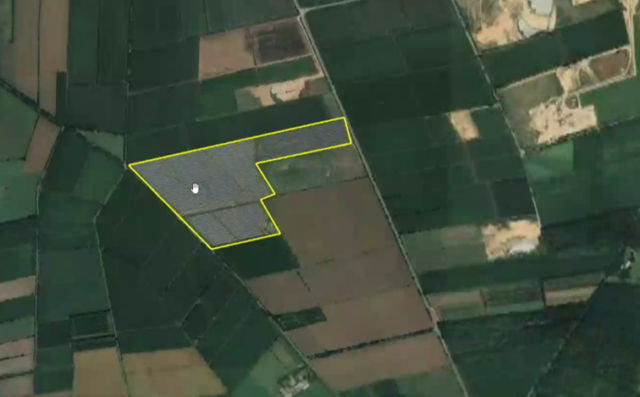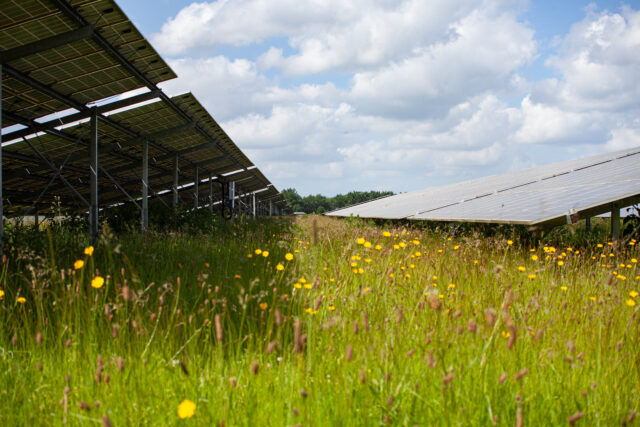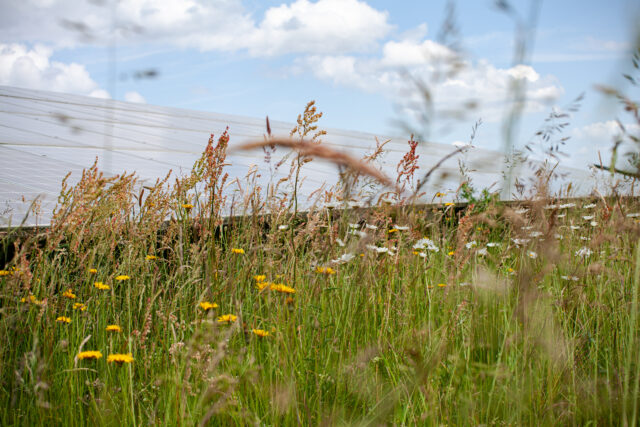Klein Rheide solar park
The Klein Rheide solar park was planned and built by Wattmanufactur in three construction phases (2015-2019) and is technically operated by the company. The park is located around one kilometre south of the town of the same name in the Schleswig-Flensburg district. The area, which was previously used for gravel extraction, now offers alternating wet conditions on sandy soils.
As early as the planning phase, care was taken to implement structural measures that specifically promote biodiversity. These include generous row spacing of almost four metres and gaps between the modules so that rainwater can drain away evenly.
The degree of sealing is less than one per cent. Open-pored paths allow rainwater to seep away and the module mounting was designed in such a way that the solar park can be completely dismantled without leaving any residue at the end of its useful life. This means that the area will remain as potential grassland or agricultural land in the long term.
The Wattmanufactur favours adapted, extensive cultivation. The absence of fertilisers and chemical pesticides promotes soil quality and allows the previously intensively used soil to regenerate. Late mowing times and the use of double-blade bar mowing technology protect ground-nesting birds and insects.
The Klein Rheide solar park was recognised as one of the most ecologically valuable solar parks in Germany in the first study on biodiversity in solar parks conducted by the Bundesverband Neue Energiewirtschaft e.V. in 2021. The measures implemented by Wattmanufactur, including the installation of insect hotels, deadwood piles, wildlife corridors and nesting aids as well as the planting of flowering strips and shrubs typical of the region, have made a significant contribution to this success.
Further information on the Klein Rheide solar park measures can be found at https://wattmanufactur.de/bio-div-pv.html

Wattmanufactur GmbH & Co. KG
22.9 MW
27 ha
2015
Schleswig-Holstein
54.4335000434 - 9.47484566098
Arable land
Table of contents
| Species groups | Investigated |
|---|---|
| Plants | ✔ |
| Locusts | ✔ |
| Butterfly | ✔ |
| Dragonflies | ✔ |
| Reptiles | ✔ |
| Amphibians | ✔ |
| Birds | ✔ |
| Bats | |
| Miscellaneous |
✔ = Investigation carried out on behalf of the operators
Natural environment and special features
Schleswig-Holstein Geest
The area surrounding the Klein Rheide solar park consists almost exclusively of farmland. There are also several gravel works within a radius of around one kilometre. The Jagel air base is located around three kilometres north of the plant. In the immediate vicinity, a tree-lined country road borders the south-west side of the solar park. It is bordered by bends and trees typical of the landscape. A pond with a diameter of less than 50 metres borders the north-eastern part of the plant.
The solar park has no particular relief and is located at around 18 metres above sea level.
Extensive grassland seeding, No. / Code: 12.1.3 / GRE; Knicks: Shrub wall hedges, No. / Code: 2.9.1 / HWS
Floor
Podzol / brown earth podzol / gley podzol from sandy river deposits
Reinsande
Construction method
0.54
3.5m
2.1m
15°
4 pieces
20mm
These are fixed frames with cross bracing on the piles.
Polycrystalline modules were installed.
Paths were laid with a gravel base layer of 0 to 45 mm and a 0 to 5 mm layer of filling sand. Paths were also created using recycled concrete.
Management
Mowing takes place once or twice a year. Double-bladed beams are used for this. The area is also grazed with sheep. Due to the wet weather in 2024, the area was mowed and cleared very late. There are also woody structures in the area that are maintained.
Equalisation measures
The following measures were implemented as part of the development plan:
Extensive grassland: "SO area" is to be sown as species-rich permanent grassland, using suitable seed of regional origin, surrounding compensation area to be sown with the same seed.
Mowing: Occasional maintenance by mowing possible, extensive grazing permitted within the fencing, grazing with sheep is recommended on sown areas, animal density not greater than 6 sheep/ha, additional mowing only possible on one third of the area if it is not carried out before 1 July and not after 31 October and the mown material is removed, in the case of scrub encroachment due to growth avoided by browsing, the areas can be additionally mowed every three years.
Preservation of curtilages
Further details can be found in the development plan and environmental report.
Voluntary measures:
- Portioned grazing with sheep
- Annual introduction of regional seeds
- Construction of insect hotels and nesting aids on existing trees for insects
- Preservation of open waters
- Creation of sand lenses and cairns for reptiles
- Placement of bird nesting aids
- Preservation of alternating wetlands for amphibians
- Creation of wild bee quarters on modular frames
- Wildlife passages were subsequently installed.



















